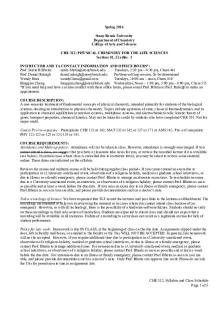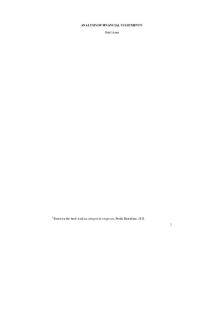Pdf PDF

| Title | |
|---|---|
| Author | Bernard Essuman |
| Course | Physical Chemistry |
| Institution | Stony Brook University |
| Pages | 5 |
| File Size | 205.4 KB |
| File Type | |
| Total Downloads | 86 |
| Total Views | 204 |
Summary
NOTES...
Description
Spring 2016 Stony Brook University Department of Chemistry College of Arts and Sciences CHE 312: PHYSICAL CHEMISTRY FOR THE LIFE SCIENCES Section: 01, Credits: 3 INSTRUCTOR AND TA CONTACT INFORMATION AND OFFICE HOURS*: Prof. Surita R Bhatia [email protected] Tuesdays, 2:30 pm – 4:30 pm, Chem 441 Prof. Daniel Raleigh [email protected] Problem-solving session, To be determined Wendy Hom [email protected] Tuesdays, 10:00 am – noon, Chem 410 Bingqian Zheng [email protected] Wednesdays, Noon – 1:00 pm, 3:00 pm – 4:00 pm, Chem 515 *If you need help and have a course conflict with these office hours, please email Prof. Bhatia or Prof. Raleigh to make an appointment. COURSE DESCRIPTION: A one-semester treatment of fundamental concepts of physical chemistry, intended primarily for students of the biological sciences desiring an introduction to physical chemistry. Topics include equations of state; classical thermodynamics and its application to chemical equilibrium in reaction systems, multiphase systems, and electrochemical cells; kinetic theory of gases; transport properties; chemical kinetics. May not be taken for credit by students who have completed CHE 301. Not for major credit. Course Pre/co-requisites: Prerequisite: CHE 132 or 142; MAT 132 or 142 or 127 or 171 or AMS 161. Pre- or Corequisite: PHY 121/123 or 125 or 131/133 or 141. COURSE REQUIREMENTS: Attendance and Make-up policy: Attendance will not be taken in class. However, attendance is strongly encouraged. If you cannot attend a class, we suggest that you have a classmate take notes for you, or review the recorded lecture if it is available (see below). In certain cases where class is cancelled due to instructor travel, you may be asked to review some material online. These dates are indicated on the syllabus. Reviews for exams and midterm exams will be held during regular class periods. If you cannot attend an exam due to participation in a University-sanctioned event, observation of a religious holiday, medical or graduate school interviews, or due to illness or a family emergency, please contact Prof. Bhatia to arrange an alternate exam time. To reschedule an exam due to a University-sanctioned event, an interview, or observance of a religious holiday, please contact Prof. Bhatia as soon as possible and at least a week before the due date. If you miss an exam due to an illness or family emergency, please contact Prof. Bhatia as soon as you are able, and please provide documentation such as a doctor’s note. Video recordings of lecture: We have requested that TLT record the lectures and post links to the lectures on Blackboard. The recordings are intended to help you in reviewing the material or in cases where you cannot attend class because of an emergency. However, as with all technology, there is the possibility of a hardware/software failure. Students should not rely on these recordings as their sole source of instruction. Students are expected to attend class and should not expect that a recording will be available in all instances. Failure of a recording to occur does not count as a legitimate excuse for lack of student performance. Policy for late work: Homework is due IN CLASS, at the beginning of class on the due date. Assignments slipped under the door, left in faculty mailboxes, or emailed to the faculty or the TAs WILL NOT BE ACCEPTED. In general, late homework will not be accepted. However, if you require additional time due to participation in a University-sanctioned event, observation of a religious holiday, medical or graduate school interviews, or due to illness or a family emergency, please contact Prof. Bhatia to arrange additional time. For extensions due to a University-sanctioned event, medical or graduate school interviews, or observance of a religious holiday, please contact Prof. Bhatia as soon as possible and at least a week before the due date. For extensions due to an illness or family emergency, please contact Prof. Bhatia as soon as you are able, and please provide documentation such as a doctor’s note. Only Prof. Bhatia can approve late work. Please do not ask the TAs for permission to turn in assignments late.
CHE 312, Syllabus and Class Schedule Page 1 of 5
Description and schedule of Required Readings and/or Assignments: Textbook: Physical Chemistry: Principles and Applications in Biological Sciences, 5th Ed., Ignacio Tinoco, Jr. et al., Prentice Hall. Please see attached schedule for detailed schedule of readings and assignments. Exams Midterm Exams: (1) Thursday, February 25, 1:00 - 2:20 PM, ESS 001 (2) Thursday, April 14, 1:00 - 2:20 PM, ESS 001 Final Exam: Monday, May 16, 5:30 pm – 8:00 pm, ESS 001 All exams will be closed book and notes. Any additional information that you need (conversion factors, etc.) will be given to you as part of the exam. Basic equations may also be given to you as part of the exam. You may use a calculator during exams (but not the calculator on your cell phone). It is your responsibility to bring a calculator to exams. COURSE OBJECTIVES At the end of this course, students should: 1. Be adept at solving quantitative problems in the chemical sciences, including correct use of significant figures, unit conversions, and dimensions. 2. Understand thermodynamic quantities such as heat, work, internal energy, enthalpy, and entropy; and be able to calculate these quantities for pure solids, liquids, and ideal gases. 3. Understand the relationship between Gibbs free energy and the equilibrium constant for chemical reactions 4. Be able to calculate or estimate the activity of components in gas mixtures and in solutions, including nonidealities arising from charged species 5. Understand the relationship between chemical potential and phase equilibria 6. Be able to solve simple phase equilibria problems using Raoult’s Law and Henry’s Law 7. Understand how colligative properties such as osmotic pressure can aid in characterization of dilute solutions of macromolecules 8. Be able to solve chemical kinetics problems using simple rate laws (e.g., first-order kinetics) 9. Understand and be able to apply rate laws arising from enzyme-catalyzed reactions (e.g., Michaelis-Menten kinetics) 10. Understand transport properties and how they are used to characterize macromolecules using techniques such as intrinsic viscosity measurements, dynamic light scattering, sedimentation, and gel electrophoresis. 11. Understand basic concepts from quantum mechanics and how these are used to interpret information from different spectroscopic methods GRADING: The relative weight for each component of the course is: Exam #1 Exam #2 Homework Final Exam
25% 25% 25% 25%
Your lowest homework grade will be dropped in calculating your homework average. In determining your grade on an exam, your thought process and methods of analysis will be weighted more heavily than your final numerical answer. Thus, if you are running out of time in an exam situation, try to explain in words what you would like to do, or what methods you would use to solve the problem. If you can do this correctly, you may get partial credit. On your homework problems, however, credit will be given for both your method of analysis and your final answer. Thus, you should take the time to check your calculations carefully. In real life, both your method of analysis AND your final answer will be important, so it is a good idea to get in the habit of checking and re-checking your calculations now. Grades will be given on an absolute scale, based on the percentage of points as indicated below: A B C D F
100 – 90 90 – 80 80 – 70 70 – 60 60 and below CHE 312, Syllabus and Class Schedule Page 2 of 5
There will be no curving of grades. If you all get above 90, I will (happily) give you all A’s, and if you all get below 60, I will (unhappily) give you all F’s. If at any point during the semester you are concerned about your grade, please come and speak to Prof. Bhatia. Plus/minus grades (e.g., A-, B+) will be given to students on the borderline of the above cut-offs at the discretion of the instructor. You are responsible for individual homework assignments and for exams. For homework assignments, you may work together in a study group, however; direct copying or paraphrasing another student's solution to a problem, or permitting your own solution to be copied or paraphrased, is considered cheating, and you could possibly receive a zero for the assignment. Be sure to properly reference any information, facts, figures, definitions, or ideas that are taken from other sources, including the Internet. To include such information without giving proper credit to the source is plagiarism. This includes both ideas that are paraphrased and text that is taken directly from another source (such text must be enclosed in quotation marks). During exams, using outside sources of information, communicating with another student in any way during an exam, or copying from another student is cheating. If you are caught cheating, you may receive a zero for the exam. For more information, please refer to the academic judiciary website at http://www.stonybrook.edu/uaa/academicjudiciary/ MEETING SCHEDULE: T-Th 1:00 pm – 2:20 pm, Earth and Space Sciences 001 CLASS PROTOCOL: Out of respect for the instructor and other students, no cell phone usage or texting are permitted during class. Please switch your phone to vibrate during class, and if you receive a call you must take, please take the call in the hallway outside of class. CLASS RESOURCES: The syllabus, homework assignments, and homework solutions will be posted on Blackboard. HOMEWORK GUIDELINES: 1. Homework should be neat and legible. We cannot grade what we cannot read. Points may be deducted for illegible answers. 2.
Turn in your homework on lined, unlined, or engineering paper. You may use the backsides of scrap printer paper, as long as the paper is still in good condition.
3.
Staple pages of each homework set together. Do not rely on the faculty or the TAs to bring staplers to class or keep track of loose pages of your assignments.
4.
On each page, please print the following in the upper right hand corner: your name, the course number, the date, and the homework number.
5.
Always show your work and/or describe your method of analysis. No credit will be given if you only write down the final answer.
6.
State all assumptions clearly and justify their use.
7.
Indicate if equations used in the homework come from class notes or the text. If they come from the text, include the equation number.
8.
Clearly define any variables that you use. For thermodynamic problems involving a complex process, draw and label a diagram with the relevant state variables, and indicate the system clearly.
9.
Manipulate your equations symbolically, then substitute numerical values and calculate.
10.
Properly reference any additional information you use.
11.
For problems requiring a numerical answer, check your calculations several times, and draw a box around your final answer. ALWAYS check to make sure you have the correct units.
CHE 312, Syllabus and Class Schedule Page 3 of 5
CLASS SCHEDULE AND READINGS: All readings from Physical Chemistry: Principles and Applications in Biological Sciences, 5th Ed., Ignacio Tinoco, Jr. et al., Prentice Hall. Week Date Topics Reading and handouts Assignments due 1 1/26 Class expectations and guidelines Ch. 1 Systems and surroundings Ch. 2, pp. 13 – 26 Pressure and work The first law of thermodynamics 1/28 NO IN-CLASS LECTURE. Please review on-line Ch. 2, pp. 26 – 31 lectures for: HW #1 State variables, energy, and enthalpy 2 2/2 Dependence of energy and enthalpy of a pure substance Ch. 2, pp. 31 – 39 on P, V, and T Phase changes 2/4 Energy changes for chemical reactions Ch. 2, pp. 39 – 47 HW #1 Standard enthalpy of formation HW #2 Bond energies 3 2/9 Entropy and the second law of thermodynamics Ch. 3, pp. 55 – 62 2/11 The third law of thermodynamics Ch. 3, pp. 66 – 72 HW #2 Calculation of entropy HW #3 4 2/16 NO IN-CLASS LECTURE. Please review on-line Ch. 3, pp. 62 – 65 lectures for: Molecular interpretation of entropy 2/18 NO IN-CLASS LECTURE. Please review on-line Ch. 3, pp. 72 – 80 HW #3 (turn in at box lectures for: outside of Chem 441 HW #4 by 5:00 pm) Gibbs free energy and Helmholtz free energy 5 2/23 Partial derivatives in thermodynamics Ch. 3, pp. 87 – 93 Derivation of Gibbs-Helmholtz Equation Review for Exam #1 2/25 EXAM #1 6 3/1 Free energy and chemical equilibria Ch. 4, pp. 101 – 108 Partial molar quantities and the chemical potential The equilibrium constant 3/3 Nonideal systems Ch. 4, pp. 108 – 119 HW #4 Activity and activity coefficients HW #5 7 3/8 Standard Gibbs free energy Ch. 4, pp. 119 – 129 Henderson-Hasselbalch equation 3/10 Galvanic cells Ch. 7, pp. 238 – 248 HW #5 HW #6 SPRING BREAK 8 3/22 Conditions for phase equilibria Ch. 6, pp. 196 – 208 Clausius-Clapeyron equation Partitioning between phases 3/24 NO IN-CLASS LECTURE. Please review on-line Ch. 6, pp. 208 – 213, HW #6 (turn in at box lectures for: pp. 225 – 227 outside of Chem 441 by 5:00 pm) Boiling point and Freezing point of solutions HW #7 Dialysis and binding phenomena 9 3/29 Osmotic pressure Ch. 6, pp. 227 – 230 3/31 Molecular motion and Maxwell-Boltzmann Statistics Ch. 5, pp. 151 – 156, HW #7 Ch. 8, pp. 264 – 268 HW #8 10 4/5 Random walks and diffusion Ch. 5, pp. 166 – 172 Ch. 8, pp. 268 – 272 CHE 312, Syllabus and Class Schedule Page 4 of 5
4/7 11
4/12
12
4/14 4/19 4/21
13
4/26
4/28
14
5/3 5/5
Measurement of diffusion coefficients Dynamic light scattering Kinetics Reaction order, First order reactions Review for Exam #2 EXAM #2 Reaction mechanisms Equilibrium and kinetics Temperature dependence NO IN-CLASS LECTURE. Please review on-line lectures for: Enzymes and Michaelis-Menten kinetics NO IN-CLASS LECTURE. Please review on-line lectures for: Competition and inhibition Quantized energy Introduction to spectroscopy and biochemical applications
HW #9
HW #8
Ch. 9, pp. 305 – 317
Ch. 9, pp. 327 – 333 Ch. 9, pp. 333 – 341 HW #10 Ch. 10, pp. 378 – 390
Ch. 10, pp. 391 – 396 HW #11 Ch. 11, pp. 408 – 415 Ch. 13, pp. 489 – 493
HW #9
HW #10 ((turn in at box outside of Chem 441 by 5:00 pm) HW #11
DISABILITY SUPPORT SERVICES (DSS) STATEMENT If you have a physical, psychological, medical or learning disability that may impact your course work, please contact Disability Support Services, ECC (Educational Communications Center) Building, room128, (631) 632-6748. They will determine with you what accommodations, if any, are necessary and appropriate. All information and documentation is confidential. Students who require assistance during emergency evacuation are encouraged to discuss their needs with their professors and Disability Support Services. For procedures and information go to the following website: http://www.stonybrook.edu/ehs/fire/disabilities ACADEMIC INTEGRITY STATEMENT Each student must pursue his or her academic goals honestly and be personally accountable for all submitted work. Representing another person's work as your own is always wrong. Faculty are required to report any suspected instances of academic dishonesty to the Academic Judiciary. Faculty in the Health Sciences Center (School of Health Technology & Management, Nursing, Social Welfare, Dental Medicine) and School of Medicine are required to follow their school-specific procedures. For more comprehensive information on academic integrity, including categories of academic dishonesty, please refer to the academic judiciary website at http://www.stonybrook.edu/uaa/academicjudiciary/ CRITICAL INCIDENT MANAGEMENT Stony Brook University expects students to respect the rights, privileges, and property of other people. Faculty are required to report to the Office of Judicial Affairs any disruptive behavior that interrupts their ability to teach, compromises the safety of the learning environment, or inhibits students' ability to learn. Faculty in the HSC Schools and the School of Medicine are required to follow their school-specific procedures.
CHE 312, Syllabus and Class Schedule Page 5 of 5...
Similar Free PDFs

- 9 Pages

Common Good PDF - pdf
- 7 Pages

- 2 Pages

- 43 Pages

- 47 Pages

- 5 Pages

- 130 Pages

- 16 Pages

Pdf Daniel - pdf
- 223 Pages

Keselamatan_Maritim_2.pdf
- 147 Pages

arens_auditing_14ce_ism_c18.pdf
- 25 Pages

Pdfcoffee - Pdf
- 39 Pages

Τσάμηδες PDF
- 8 Pages

Fundoscopia PDF
- 2 Pages
Popular Institutions
- Tinajero National High School - Annex
- Politeknik Caltex Riau
- Yokohama City University
- SGT University
- University of Al-Qadisiyah
- Divine Word College of Vigan
- Techniek College Rotterdam
- Universidade de Santiago
- Universiti Teknologi MARA Cawangan Johor Kampus Pasir Gudang
- Poltekkes Kemenkes Yogyakarta
- Baguio City National High School
- Colegio san marcos
- preparatoria uno
- Centro de Bachillerato Tecnológico Industrial y de Servicios No. 107
- Dalian Maritime University
- Quang Trung Secondary School
- Colegio Tecnológico en Informática
- Corporación Regional de Educación Superior
- Grupo CEDVA
- Dar Al Uloom University
- Centro de Estudios Preuniversitarios de la Universidad Nacional de Ingeniería
- 上智大学
- Aakash International School, Nuna Majara
- San Felipe Neri Catholic School
- Kang Chiao International School - New Taipei City
- Misamis Occidental National High School
- Institución Educativa Escuela Normal Juan Ladrilleros
- Kolehiyo ng Pantukan
- Batanes State College
- Instituto Continental
- Sekolah Menengah Kejuruan Kesehatan Kaltara (Tarakan)
- Colegio de La Inmaculada Concepcion - Cebu

![[PDF] Cours complet marketing en PDF Télécharger PDF](https://pdfedu.com/img/crop/172x258/gwrwp9kme218.jpg)